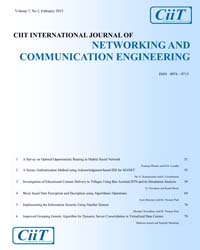Application of Markovian in Point to Point Networks with Multiple Controllers Using Nash Equilibrium
Subscribe/Renew Journal
Congestion control is one of the most fundamental problems in computer networks and has been widely studied for decades. The flow control in computer communication networks is modeled by the application of a Markovian queuing system. The main aim of the flow control of Markovian queueing network with multiple controllers is (i) to maximize the average network throughput subject to a constraint on the average network delay (ii) under individual objectives where each users maximizes the corresponding average user throughput subject to the average user time delay constraint. The network optimization problems depend on the parameters of the network only through the conditional estimates of the total arrival and the total departure rates. Using linear programming problem, the network optimal flow control is showed to be a window mechanism. The optimal decentralized flow control under the user's performance in a multiple objective optimization problem is analyzed which leads to a game theoretic formulation with constraints. Structural constraints are obtained for the user optimization criterion under the results of separation theorem. The application of product form queueing is considered in the point to point packet switching network. Multiple routing chains are used to model the different routing behavior of packets. In point to point switching network, a packet can steps forward from one node to the next beside the route allocation. The performance measures which describe the packet transported by the network between the source and sink pairs. Nash equilibrium solution of this formulation is demonstrated to be a set of window-type mechanisms. The application of the Nash equilibrium concepts in decentralized flow control with throughput and time delay criteria which represents a behavior of a system are obtained.
Keywords

Abstract Views: 272

PDF Views: 2



